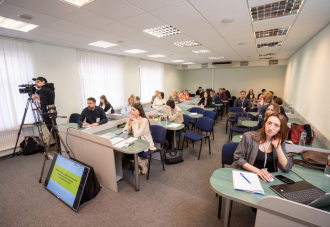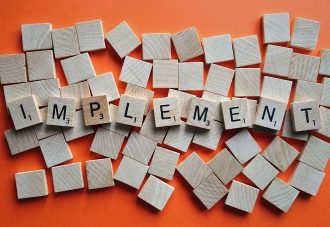What do we mean when we talk about gender? And what about inclusion?
What the term “gender-inclusive approach” means, and how to implement changes in the organization in practice – Natalia Seliukova, a mentor of the Mentorship Program 3.0, Ukrprostir NGO, told us about this.
Tip 1: gender policy should be adopted and accepted by all representatives of the organization
According to Natalia Seliukova, it is not necessary to develop policy for the sake of policy. Gender policy (procedures, rules) should be adopted and accepted by all representatives of the organization, the best way is to develop it together and communicate it to all those involved in the activities.
It is necessary to understand what the gender issue affects and which indicators really matter. That is, any organization, if it is effective and does something, does this not for nothing but to achieve a goal. Understanding the purpose and those affected by our activities is extremely important.
“A gender-inclusive approach is not about individual groups, it’s about everyone. I am a supporter of the approach that a problem is considered solved if it is solved for the vulnerable groups,” adds Natalia Seliukova. “For me, a gender-inclusive approach is human-centered.”
Mrs. Natalia says that now there are so many vulnerabilities that it is difficult to count them: these are include internally displaced persons, refugees, military personnel, spouses of military personnel, children of military personnel, parents of military personnel, people with disabilities, elderly people, low-income people, people with many children… And all of them have certain characteristics that we must take into account.
According to Natalia Seliukova, if gender-inclusive policies are to be prescribed in the organization, we should take a practical approach: “This is not a theory – what gender is, what inclusion is and what we need to do about it. It’s the organization’s clear understanding of how it can apply this to its activities.”
That is, when we talk about gender and gender policy in general, we should pay attention first of all to the target audience.
“Gender is about our people that we work with, our target groups. We have to know our target audience like the back of our hand, that is, we must know almost everything about it. Not to guess, but to study,” Natalia Seliukova emphasizes. “We need to know what their needs are, what interests them, worries them, scares them, attracts them. And I mean not in general, but when they perform different social roles. And we also need to conduct regular gender analyzes to track changes (first the lockdown, then the full-scale invasion very clearly demonstrated the changes in needs and opportunities).
Why do we need this? If we hold any events, the number of men and women who came to our event, responded to our inquiries, shows whose interests we affected. And we have to analyze and understand why others did not respond. What did we do wrong?
There are no uninteresting events, sometimes we just haven’t expanded our understanding of a topic and failed to communicate its connection to a wider circle of our potential supporters. That is, the needs of separate categories of women and men were not taken into account – the gender aspect.
When providing the same opportunity to participate in events, get involved in any processes, we must take into account that men and women cannot be the same. Therefore, it cannot be about equality, but rather about fairness.”
Natalia Seliukova is currently a mentor of the Boiarka Community Foundation from the city of Boiarka, Kyiv Region. This organization is focused on promoting conditions to support local businesses.
According to Ms. Natalia, consideration of gender is also important at the stage of developing advocacy campaigns, because it is about opportunities for influence: “How well we understand our target audience, particularly from a gender perspective, determines our result.”
Tip 2: pay attention to gender-inclusive practices
According to the expert, the organization’s policies should include practical things: What it is for and how it will be used should be spelled out.
We asked Ms. Natalia if it is true that many CSOs integrate gender into their work primarily by adding a question about gender to questionnaires and registration forms.
“Even the division into ‘women, men and others’ – is it about gender or what? If we are talking about gender, then there are more than 30 identities. And if we take some of them and leave out others, this is also not very fair,” says the expert.
According to her, one can leave ‘men and women’ as a definition of gender – the key question is what we want to do with this information.
“To see how many women and men came to our events? OK, so we have this information, what’s next? At the very least, we need to include distribution by age group to understand which category comes to us more often.”
Natalia Seliukova advises: This kind of information can be used to expand an organization’s target audience.
“If we see that, for example, the majority of our event participants are women, and we want to attract men, we need to understand what we did wrong, why fewer men came. Either the topic was wrong, or the format was wrong, or we were spreading the information in the wrong place, or we needed to do extra activities to get men interested. Because it turns out that even in peacetime men are less involved in public life than women. Today, in wartime, in order to attract women with children, we have to take into account that not everyone is willing to leave their child at home for fear of danger. Therefore, you should consider what to do with the children during the event.”
The expert advises to use all these figures in order to understand what the organization should do next in order to even things out.
Tip 3: analyze the different areas of influence of the gender-inclusive approach
Gender-inclusive approaches should be applied at various stages of the organization’s activities. If you track the results after applying the gender approach and without applying it, they may be different. Even target audiences may change. Engaging more or less equal number of women and men can affect the quality of activities.
Does the issue of gender apply to absolutely all topics and activities of all organizations? The answer is yes.
Natalia Seliukova shares the story of how she attended a conference where the issue of gender was raised in relation to climate change.
“Supposedly these are completely unrelated things, although this issue can be considered from different points of view: On the one hand, it is the impact of women and men on climate change, and on the other hand, it’s a question of who will be more affected by climate change.”
One of the conclusions is that the most vulnerable will become even more vulnerable. And these are mostly women who have a lower income. If we are talking about warming, not all women who earn little and raise one or two children on their own can buy an air conditioner and pay significantly higher energy bills.
On the other hand, we can analyze how men and women affect climate change and what environmental impact they have. For example, women take care of children more, and here the question is where diapers go, whether they decompose. Or menstrual pads. However, another question is to what extent men are more responsible when it comes to waste disposal, etc.
According to Ms. Natalia, such examples can be broken down into many components: “It’s about the fact that even some global things that do not apply directly to women and men have completely different effects on different categories of the population. And it’s about the gender aspect.”
Consequently, when it comes to the organization’s activities, the expert advises paying attention to both how men and women affect the problem the CSO is trying to solve and how the activities will affect women and men.
The book recommended by Natalia Seliukova: Caroline Criado Perez Invisible Women: Exposing Data Bias in a World Designed for Men
The material was prepared for the Mentorship Program 3.0 implemented as part of the Project Ukraine Civil Society Sectoral Support Activity implemented by the Initiative Center to Support Social Action “Ednannia” in partnership with the Ukrainian Center for Independent Political Research (UCIPR) and Centre for Democracy and Rule of Law (CEDEM) with the sincere support of the American people through United States Agency for International Development.



